Recording Patagonia’s untamed beauty

Sound recordist Thomas Rex Beverly relies on Sennheiser’s MKH series condenser microphones to capture the sounds of nature
If you are a cinema fan, you have very likely come across the nature recordings of Thomas Rex Beverly, adventure field recordist. Beverly has compiled around 100 sound libraries that offer a stunning choice of sounds from the natural world. Beverly’s sound libraries are used by OSCAR, Emmy, and Golden Globe winners for major film, television, and video game projects. As Tim Farrell, Emmy winning Sound Designer and Sound Effects Editor (Star Trek: Picard, Antman: Quantumania, Obi-Wan Kenobi, The Walking Dead, Crash) put it: “Thomas’ unique and well recorded sounds have helped me create the sonic universe of Star Trek.” Beverly’s latest expedition this February lasted three weeks and took him to the multifarious landscapes of Patagonia.
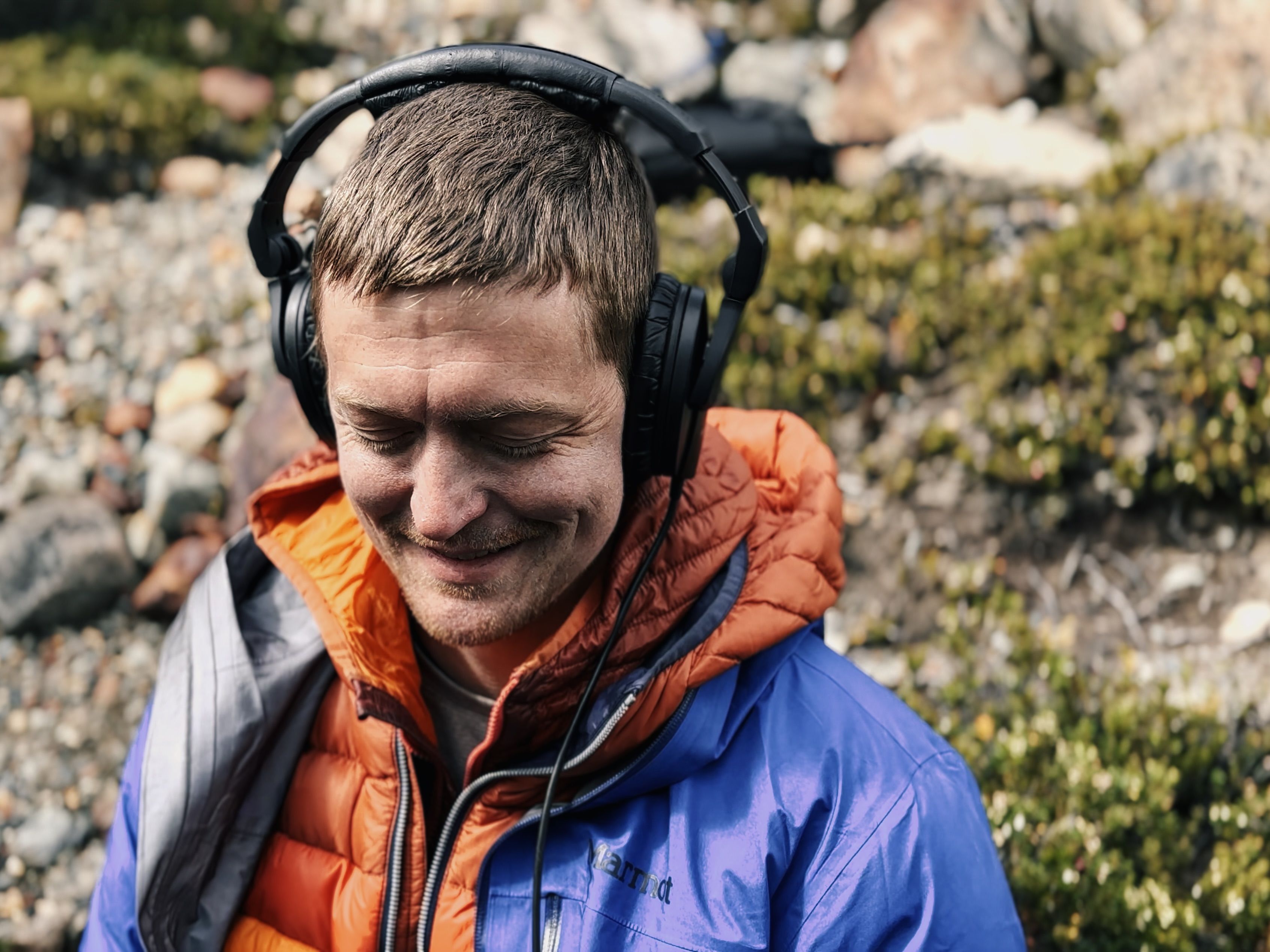
“Patagonia’s breathtaking landscape with its expansive open spaces, gigantic mountains, and some very wild weather has deeply captivated me,” says Beverly. “It’s an amazing ecosystem down there.”
Gear up!
For the Patagonia Expedition, Beverly packed a range of outdoor gear, eight recorders, eight microphone rigs tailored to various recording needs and session lengths, DIY hydrophones, cameras, SD cards, a few sets of Sennheiser HD 280 PRO headphones, and multiple sets of batteries.
“When travelling by plane, there’s a restriction on the battery size allowed, typically around 100 watt-hours, which directly impacts the number of recording sessions I can undertake. My mic setup includes high-quality options like the Sennheiser MKH 8020 and MKH 8040, powered by 48V phantom, alongside 24V phantom power and plug-in-power mics for my drop rigs,” he elaborates. Beverly also tested the latest Sennheiser MKH 8030 figure-8 microphone during this trip.
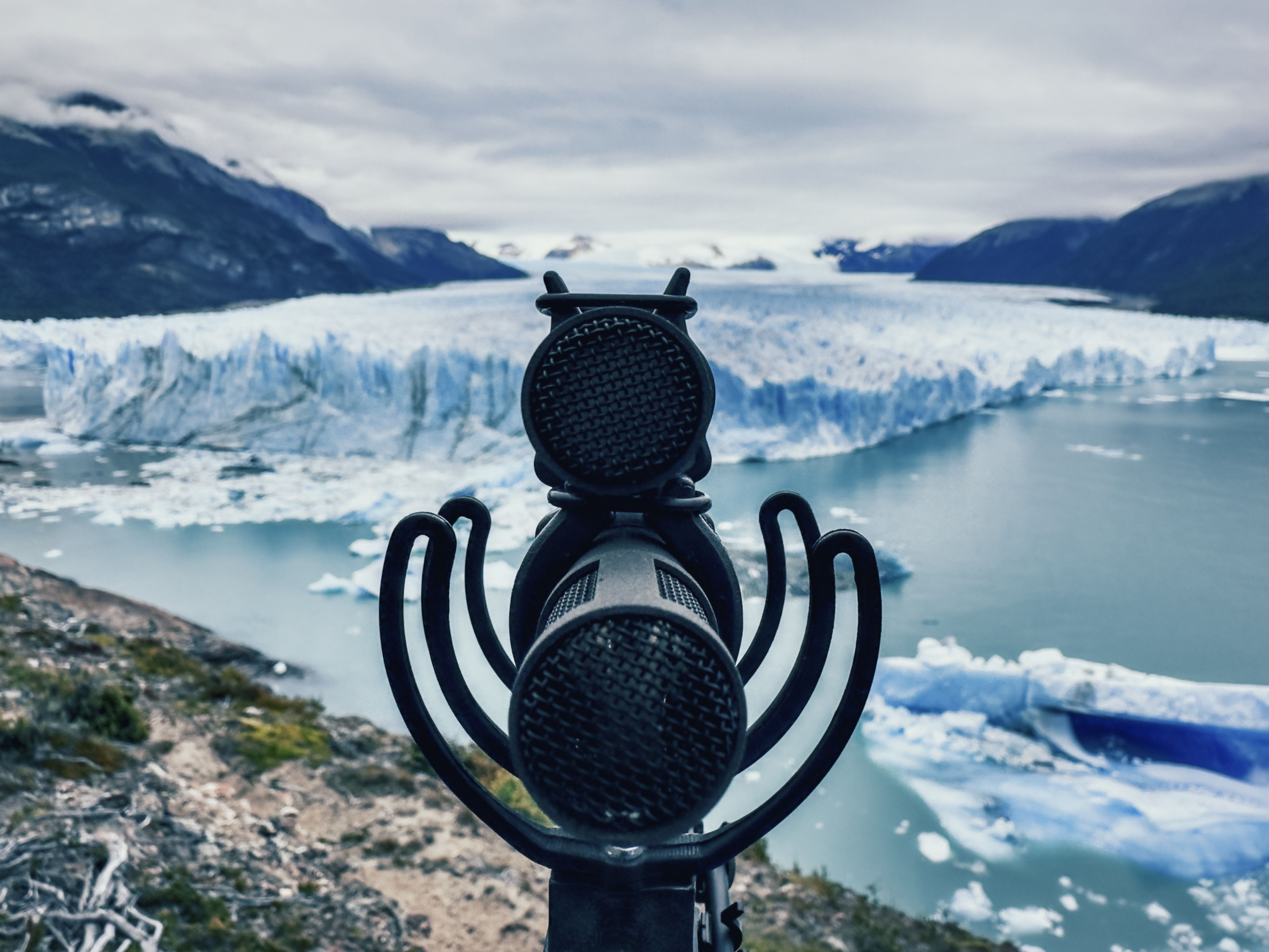
(photo taken at Moreno Glacier)
10,000 kms to El Chalten
Thomas and his colleague Andy, who accompanied him on this expedition, set up their base camp in El Chaltén, known as the national capital of trekking in Argentina and the starting point for several trails surrounding the peaks of Cerro Torre and Monte Fitz Roy.
They went on day hikes and overnight camping trips for a total of 12 days, exploring and recording the sounds of the region. Beverly explains: “You go from extremely dry desert-type landscapes with cacti, guanacos and brush bushes to 100-foot trees, to smaller alpine trees, to moss, to giant mountains, to the ice cap – all within a span of maybe 10 miles.”
Recording howling winds
When hurricane-force gales funnelled through El Chaltén, Beverly had the perfect opportunity to record extreme wind sounds. “One of the best ways to record howling and whistling winds is by capturing power lines resonating in the wind or the sound of windows cracking when the wind blows at 80 miles an hour. These produce very melodic whistles that sound editors love to use in film scenes.”
During the first days, Beverly ventured out for shorter hikes to experiment with the MKH 8030 microphone and hopes of recording wildlife like austral parakeets, austral pygmy owls, large Magellanic woodpeckers, guanacos, and Andean pumas. Beverly jokes that when it came to pumas, he definitely didn’t want to attract any attention, so he used some of his ‘drop’ microphone rigs, which recorded for up to seven days by themselves.
“When trying to get wildlife sounds, I like to place my equipment so that I can record isolated wildlife that will hopefully come extremely close to the microphones,” Beverly explains. “When austral parakeets fly by really close it sounds like a little fighter plane zooming. When they land inches from the mics, the wooshing of their flapping wings is like a Game of Thrones dragon touching down.”
Backpacking adventure
After recording around El Chaltén, Beverly, his friend, a specially hired mountaineering guide and a porter embarked on a four-day backpacking trip to Torre Glacier. A river crossing marked the point that separates the hikers from the climbers, who cross the river to reach the giant peaks.
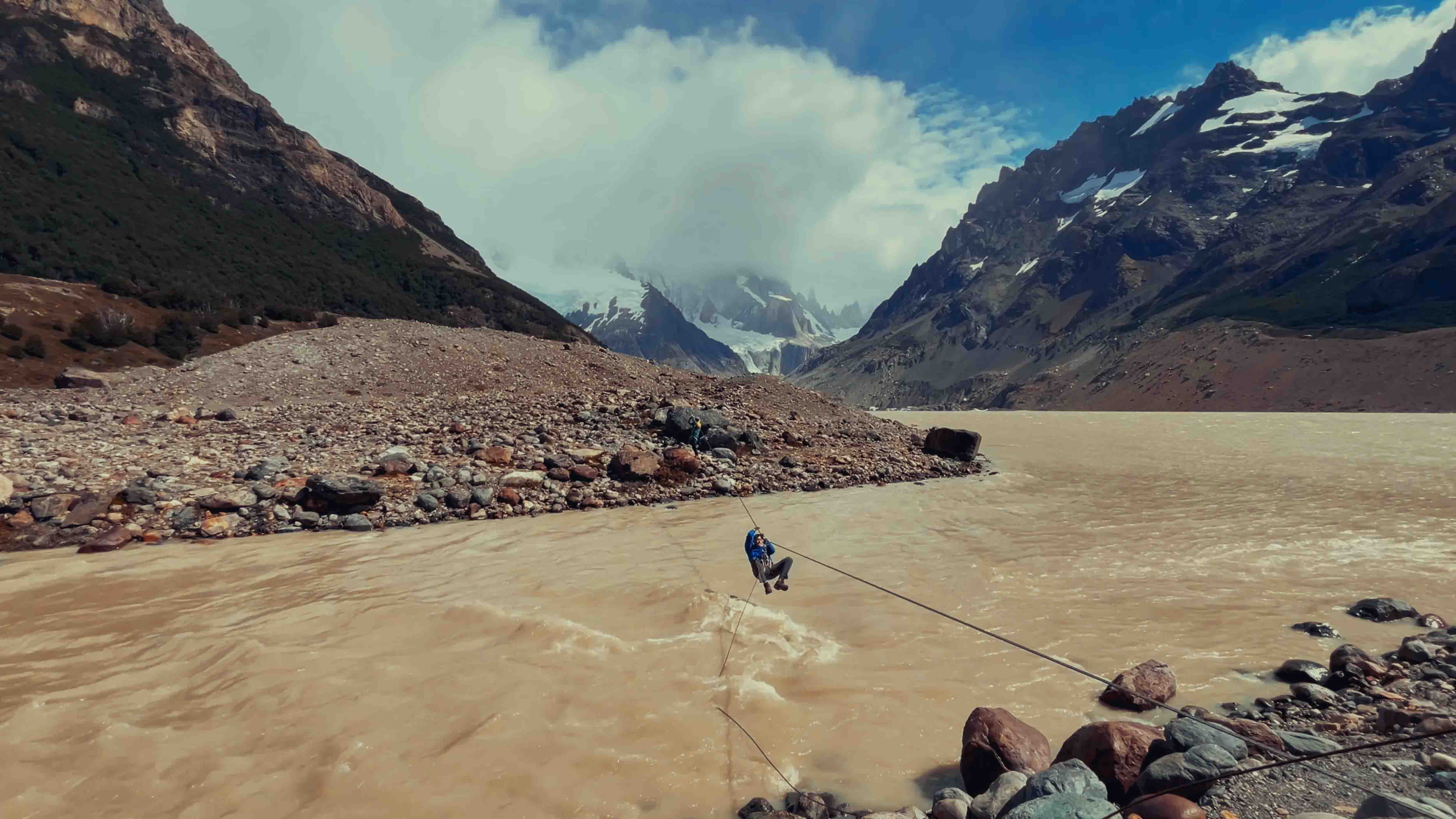
Past the river, the crew found themselves in a forest made up entirely of lenga beech. “Most of these trees are very old and tall, protected in the valley from powerful winds,” Beverly says. “Interestingly, the lenga beech has very small leaves that don’t rattle, much like a typical deciduous tree. The whole branch moves instead, more like a long-needled coniferous tree. It’s a very soothing sound when the wind has a low speed, but it has an incredible roar to it when big gusts of wind come through.”
Some of the most captivating sounds he recorded was the rain inside a giant hollow log of a lenga beech, which Beverly fondly calls the ‘cello of the forest’. “The log adds a unique character by allowing you to hear the rain both outside and through the wood,” he says. “You need to find a well-worn log with a thin layer of wood around the hole and large flakes peeling off. This creates a chromatic rain sound that is soothing, with a woody, plopping, and pinging texture, resulting in a beautiful rain melody.”
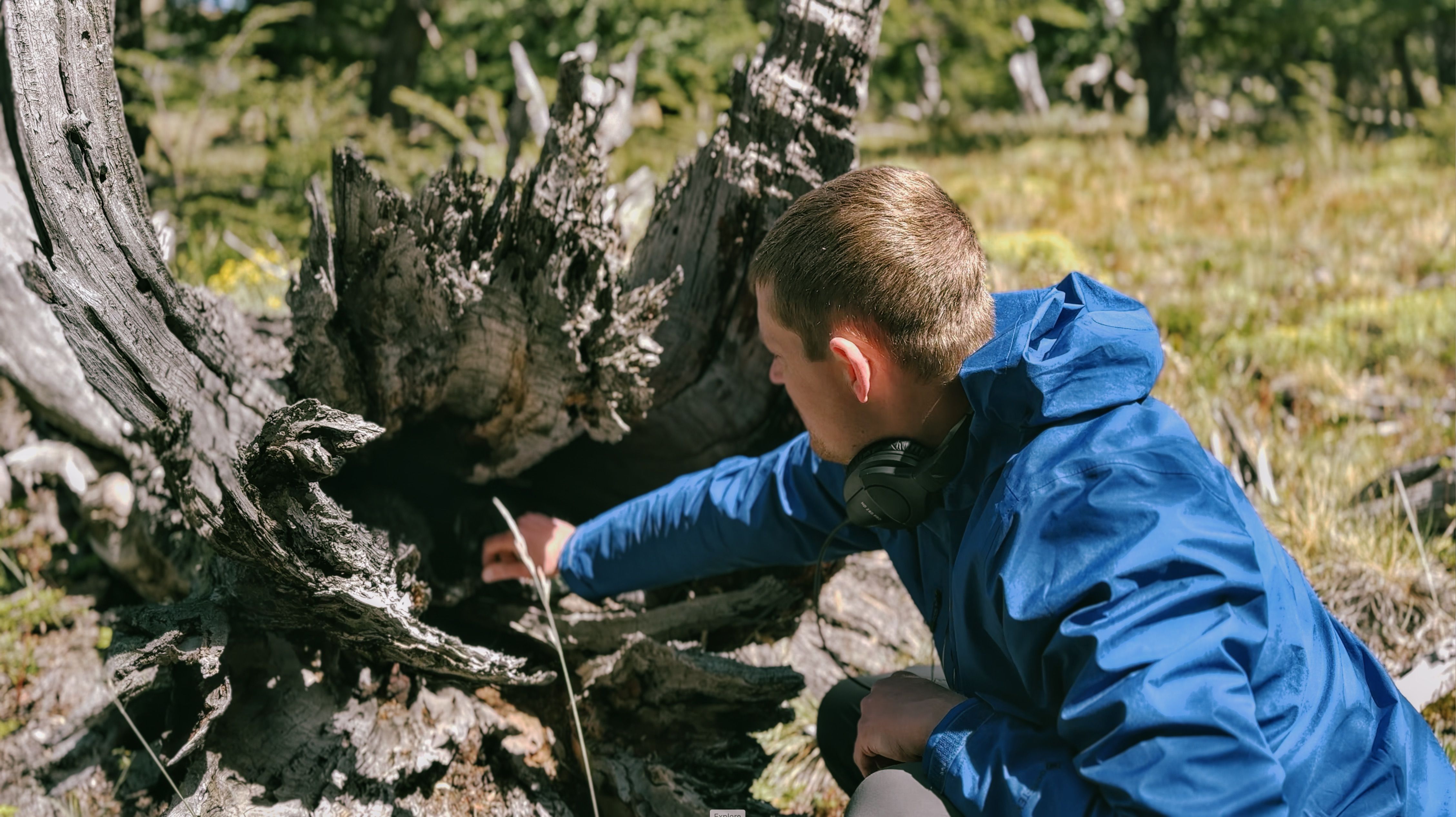
Capturing the roar of the wind with Sennheiser MKH 8040
A truly unique experience happened one night while they were camping. “The powerful winds were very intermittent and would sometimes stop completely between gusts. The calm between gusts felt like you were in the eye of the hurricane. Then you could put your hand or your ear down on the earth and feel it vibrating. You could sense the wind coming because the sound travels faster through dense ground than through the air. That was the first time I experienced the thunderous roar of the wind coming through the earth before it arrived in massive waves,” says Beverly.
Beverly notes that recording the wind is always a challenge, the key question being how to capture all the details amidst the noise. “Sometimes the wind can turn into a roar, and so a lot of what I was doing was getting a mix of the power of that roar but also the close-up details, whether it’s the rustling leaves, the canopy sounds, or a branch creaking with an ominous, eerie groan as the wind passes through,” he explains.
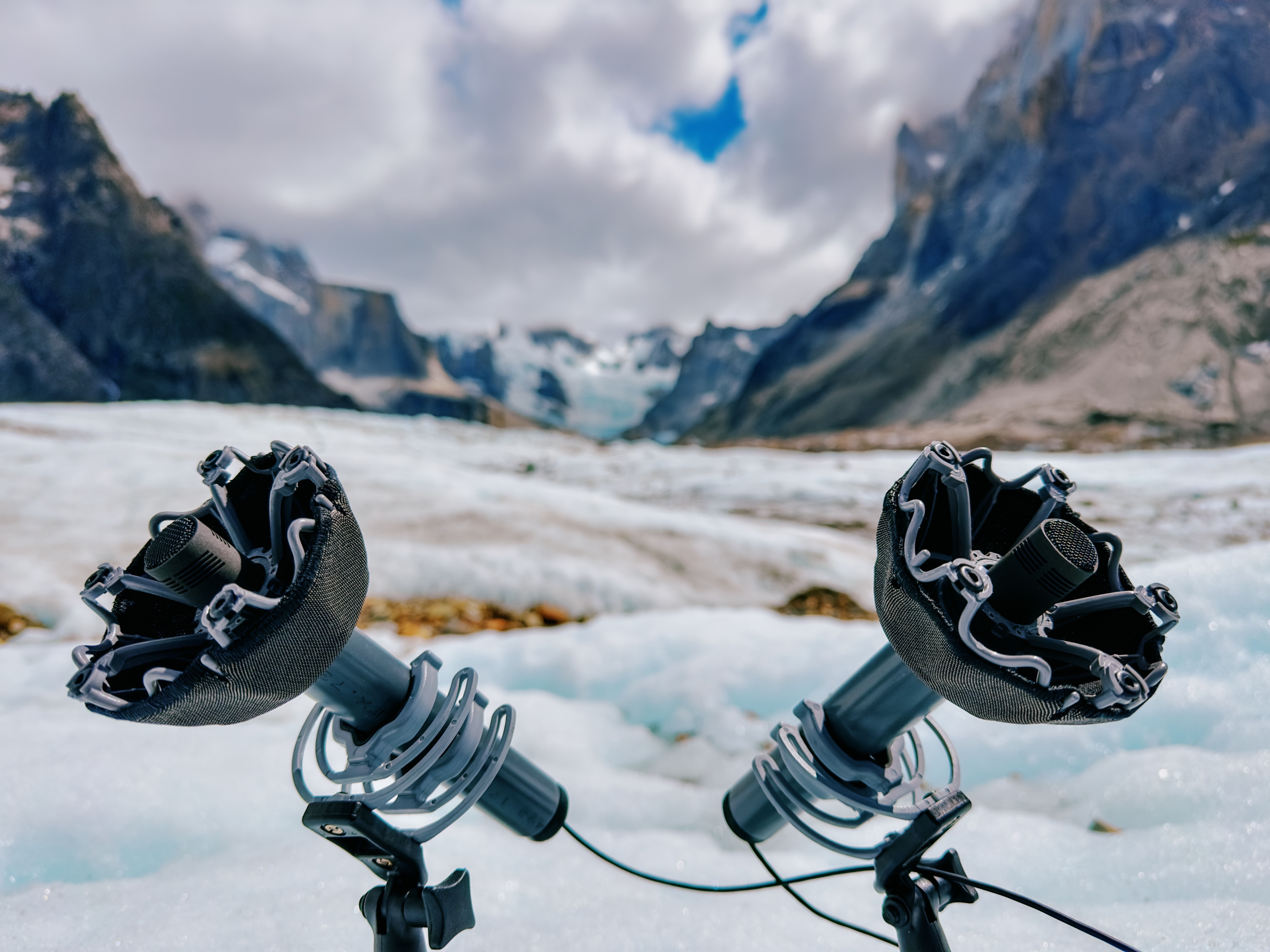
The microphones were set up in ORTF to create wider stereo image that works well for ambience
Beverly used the Sennheiser MKH 8040 to capture this unique experience, choosing these microphones because they are “I can mount them in an ORTF setup that is compact but still retains a wide and immersive stereo image. “You get a strong sense of movement through the stereo image as the wind is whipping by. The MKH 8040s were perfect for capturing that,” he adds.
Recording glacier sounds
The Torre Glacier, which the team finally reached, has retreated up the valley significantly in the last ten years. Following their mountaineering guide, they reached a spot where icebergs were calving off the glacier, and then trapped by rocks in a small area.
“I could throw some hydrophones into the part of the lake filled with icebergs, capturing the sound of them shifting and melting,” he explains. “I discovered that the icebergs here, confined to such a small space, produced more squeaking and creaking sounds. It revealed sounds I didn’t know existed. One night it rained heavily, so the hydrophones also captured the underwater rain.”
“When I first listened to these recordings, I thought they were awful—they do sound terrible at normal speed. However, when pitched down two octaves from 192 kHz to 48 kHz, magic happens. The way the raindrops hit the water makes the rain much more ultrasonic, causing it to sound hissy and piercing at normal speed. But when slowed down, it sounds amazing. Most of these recordings were made in a glacier lagoon under weird conditions. All the icebergs bunched up and rubbed together due to a rock peninsula that allowed a little water through but kept the icebergs confined. The icebergs were so dense that there wasn’t enough room for the wind to create waves. The wild Patagonia winds thrashed the icebergs around, but all they could do was rub against each other. They creaked, groaned, purred, grunted, and crackled. Adding rain to the mix created an amazing weather soundscape where the icebergs’ creaks and bubble chirps replaced the emotive branch creaks and birdsong of a real forest in a storm.”
Beverly recalls a striking moment when, after leaving one of his recording rigs in an ice cave for two days, he returned to find the entire cave had melted away. “It’s quite stunning to witness the rapid pace at which the glaciers are melting,” he admits. “This particular instance was quite eye-opening.”

capturing the sound of them shifting and melting.”
Surrounded by the majestic valley, with Fitz Roy Mountain on one side, Cerro Torre on the other, and the vast ice sheet behind it, Beverly reflects on the awe-inspiring ecosystem of Patagonia. “The combination of towering mountains, deep valleys, and the expansive ice sheet creates a truly unique environment,” he says. “It’s a place filled with unparalleled beauty and unique sounds that resonate with a purity and grandeur you simply can’t find anywhere else.
“The Patagonia Expedition has been a remarkable experience, not only challenging me to explore new territories but also uncovering sounds I never knew existed. Each trip is unique and this one, with its blend of challenges and incredible moments and fascinating ecosystems, stands out as truly unforgettable.”
Listen to Thomas’ Patagonia Nature Album here...
...and watch his expedition video on The Pulse: Patagonia's Untamed Soundscapes | Recording Nature's Beauty
(Ends)
The high-resolution images accompanying this application story and additional photos can be downloaded here.
Thomas Rex Beverly - Field Recording in Patagonia with Sennheiser MKH mics.docx
DOCX - 6.1 Mb
Thomas Rex Beverly - Field Recording in Patagonia with Sennheiser MKH mics.pdf
PDF - 742 Kb

Kirsten Spruch
Media & Influencer Relations Manager, Sennheiser

Daniella Kohan
Communications Manager - Americas & ANZ, Sennheiser Electronic Corporation


